Portuguese and German Intonation Contours in a Two-Way Immersion School
Abstract
1. Introduction
2. Prosody of Yes–No Interrogatives
2.1. Yes–No Interrogatives in Portuguese
 | |
| (1) | O poeta cantou uma manhã angeliCAL? |
| ‘Did the poet sing an angelical morning?’ |
 | |
| (2) | As meninas angolanas LÊramnola? |
| ’Did the Angolan girls read it to us?’ |
 | |
| (3) | Vai sair HOje? |
| ‘Are you going out today?’ |
 | |
| (4) | Vai sair HOje? |
| ‘Are you going out today?’ |
2.2. Yes–No Interrogatives in German
| (5) | Karl studiert in Potsdam. |
| ‘Karl studies in Potsdam.’ |
| (6) | Studiert Karl in Potsdam? |
| ‘Does Karl study in Potsdam?’ |
 | |
| (7) | Wollen Sie BaNAnen haben? |
| ‘Would you like some bananas?’ |
3. Research Aims and Questions
- RQ1
- How do children realise yes–no interrogatives in the different Portuguese varieties?
- RQ2
- How do children realise yes–no interrogatives in German?
- RQ3
- Is there evidence of prosodic transfer in any of the two, Portuguese or German?
4. Method
4.1. Two-Way Immersion School—Staatliche Europa Schule Berlin
4.2. Subjects
4.3. Procedure and Materials
4.4. Coding
4.5. Analyses
5. Results
5.1. Results for the Portuguese Map Task
5.2. Results for the German Map Task
6. Discussion
7. Conclusions
Funding
Institutional Review Board Statement
Informed Consent Statement
Data Availability Statement
Acknowledgments
Conflicts of Interest
Abbreviations
| SEP | Standard European Portuguese |
| MMP | Maputo Mozambique Portuguese |
| FLBP | Florianópolis Brazilian Portuguese |
| SPBP | São Paulo Brazilian Portuguese |
| RJBP | Rio de Janeiro Brazilian Portuguese |
| NEBP | Northeastern Brazilian Portuguese |
| SG | Standard German |
| 1 | One child reportedly has a parent who speaks an Angolan variety of Portuguese. To the best of my knowledge, there are no published descriptions of the intonation of neutral yes–no interrogatives in this variety. |
| 2 | The examples shown are based on descriptions made by the authors cited as well as F0 contours graphically reported in the literature. These contours are exemplified in  in form of stylised F0 contours (Donnelly 2013). in form of stylised F0 contours (Donnelly 2013). |
| 3 | The rhetorical question is described as a hybrid type of utterance. The rhetoric question has the syntactic surface structure of an interrogative but may be used as an assertion of the opposite polarity of their interrogative structure (Wochner et al. 2015). |
| 4 | The SESB offers bilingual education tracks that combine German with English, French, Greek, Italian, Polish, Russian, Spanish, Turkish or Portuguese. |
| 5 | The degree to which a child identified with a Portuguese-speaking culture or not was admittedly difficult to measure. However, family history often seemed to be connected with linguistic choices. A stronger identification with the German-speaking culture was noticed, for example, in the case of divorced parents when the German speaking parent had custody, or for children whose parent’s first language is not exclusively Portuguese, in the case of multilingual parents from African countries. |
| 6 | When making use of the term proficiency this refers to a spontaneous, self-confident use of either language as well as an effortless participation in the experimental task. |
| 7 | The author is a native-like speaker of German and a fluent speaker of Portuguese. The second annotator is an expert on intonation of Romance languages and a fluent speaker of German. The third and fourth annotators are trained in phonological notation with ToBI and are native speakers of SPBP and SG. |
| 8 | FER’s family had recently relocated to Germany and he was the only Portuguese-dominant child in the class. |
References
- Arnhold, Anja, Aoju Chen, and Juhani Järvikivi. 2016. Acquiring complex focus-marking: Finnish 4-to 5-year-olds use prosody and word order in interaction. Frontiers in Psychology 7: 1886. [Google Scholar] [CrossRef]
- Beckmann, Mary E., Julia Hirschberg, and Stefanie Shattuck-Hufnagel. 2005. The original ToBI system and the evolution of the ToBI framework. In Prosodic Typology. The Phonology of Intonation and Phrasing. Edited by Sun-Ah Jun. Cambridge: Cambridge University Press, pp. 9–54. [Google Scholar]
- Boersma, Paul, and David Weenink. 2017. Praat: Doing Phonetics by Computer. version 6.0.36. Computer Program. [Google Scholar]
- Bolinger, Dwight. 1989. Intonation and Its Uses: Melody in Grammar and Discourse. Redwood City: Stanford University Press. [Google Scholar]
- Bullock, Barbara E. 2009. Prosody in contact in French: A case study from a heritage variety in the USA. International Journal of Bilingualism 13: 165–94. [Google Scholar] [CrossRef]
- Caloi, Irene, and Jacopo Torregrossa. 2021. Home and school language practices and their effects on Heritage Language acquisition: A view from Heritage Italians in Germany. Languages 6: 50. [Google Scholar] [CrossRef]
- Castelo, Joelma. 2016. A entoação dos enunciados declarativos e interrogativos no Português do Brasil: Uma análise fonológica em variedades ao longo da Costa Atlântica. Ph.D. thesis, Universidade de Lisboa, Lisbon, Portugal. [Google Scholar]
- Castelo, Joelma, and Sónia Frota. 2017. The yes-no question contour in Brazilian Portuguese: A geographical continuum. In Studies on Variation in Portuguese. Edited by Pilar P. Barbosa, Maria da Conceição de Paiva and Celeste Rodrigues. Amsterdam: John Benjamins, pp. 111–33. [Google Scholar] [CrossRef]
- Chen, Aoju. 2011. The developmental path to phonological focus-marking in Dutch. In Prosodic Categories: Production, Perception and Comprehension. Berlin and Heidelberg: Springer, pp. 93–109. [Google Scholar]
- Cole, Jennifer, Jeremy Steffman, Stefanie Shattuck-Hufnagel, and Sam Tilsen. 2023. Hierarchical distinctions in the production and perception of nuclear tunes in American English. Laboratory Phonology 14: 1–51. [Google Scholar] [CrossRef]
- de Moraes, João Antônio. 2008. The pitch accents in Brazilian Portuguese: Analysis by synthesis. In Proceedings of Speech Prosody. Edited by P. Barbosa, S. Madureira and C. Reis. pp. 389–97, Paper presented at Speech Prosody 2008. Campinas, Brazil, May 6–9. [Google Scholar]
- Donnelly, Kevin. 2013. Representing Linguistic Pitch in (XE) LATEX. TUGboat/ 34: 223–27. [Google Scholar]
- Escudero, David, Lourdes Aguilar, Maria del Mar Vanrell, and Pilar Prieto. 2012. Analysis of inter-transcriber consistency in the Cat_ToBI prosodic labeling system. Speech Communication 54: 566–82. [Google Scholar] [CrossRef]
- Féry, Caroline. 2010. German Intonational Patterns, Volume 285 of Linguistische Arbeiten. Berlin: Walter de Gruyter. [Google Scholar]
- Frota, Sónia. 2002. Nuclear falls and rises in European Portuguese: A phonological analysis of declarative and question intonation. Probus 14: 113–46. [Google Scholar] [CrossRef]
- Frota, Sónia. 2014. The intonational phonology of European Portuguese. In Prosodic Typology II: The Phonology of Intonation and Phrasing. Edited by Sun-Ah Jun. Oxford: Oxford University Press, pp. 6–42. [Google Scholar]
- Frota, Sonia, and Marina Cruz. 2012–2015. Interactive Atlas of the Prosody of Portuguese Webplatform. Available online: https://labfon.letras.ulisboa.pt/InAPoP/methodology.html (accessed on 12 January 2015).
- Frota, Sónia, Joelma Castelo, Marisa Cruz, Verònica Crespo-Sendra, Nádia Barros, Aline Silvestre, and Marina Vigário. 2015. Melodia ou Texto? estratégias de acomodação entre melodia e texto no Português. Diadorim: Revista de estudos linguísticos e literários 17: 12–33. [Google Scholar] [CrossRef]
- Frota, Sónia, Marina Cruz, Flaviane Fernandes-Svartman, Gisela Collischonn, Aline Fonseca, Carolina Serra, Pedro Oliveira, and Marina Vigário. 2015. Intonational variation in Portuguese: European and Brazilian varieties. In Intonation in Romance. Edited by Sónia Frota and Pilar Prieto. Oxford: Oxford University Press, pp. 235–83. [Google Scholar]
- Frota, Sónia, Marisa Cruz, Joelma Castelo, Nádia Barros, Verònica Crespo-Sendra, and Marina Vigário. 2016. Tune or Text? Tune-text accommodation strategies in Portuguese. In Proceedings of Speech Prosody 2016. pp. 1129–33, Paper presented at Speech Prosody 2016. Boston, MA, USA, May 31–June 3. [Google Scholar]
- Giles, Howard, Donald M. Taylor, and Richard Bourhis. 1973. Towards a theory of interpersonal accommodation through language: Some Canadian data. Language in Society 2: 177–92. [Google Scholar] [CrossRef]
- Grice, Martine, and Stefan Baumann. 2002. Deutsche intonation und GToBI. Linguistische Berichte 191: 267–98. [Google Scholar]
- Grice, Martine, Stefan Baumann, and Ralf Benzmüller. 2005. German Intonation in Autosegmental-Metrical Phonology. In Prosodic Typology: The Phonology of Intonation and Phrasing. Edited by Sun-Ah Jun. Oxford: OUP, pp. 55–83. [Google Scholar]
- Gussenhoven, Carlos. 2004. The Phonology of Tone and Intonation. Cambridge, UK: Cambridge University Press. [Google Scholar]
- Hamers, Josiane F., and Michel Blanc. 2000. Bilinguality and Bilingualism. Cambridge, UK: Cambridge University Press. [Google Scholar]
- Hualde, José Ignacio, and Pilar Prieto. 2016. Towards an international prosodic alphabet (IPrA). Laboratory Phonology 7: 25. [Google Scholar] [CrossRef]
- Kan, Rachel T. Y., and Monika S. Schmid. 2019. Development of tonal discrimination in young heritage speakers of Cantonese. Journal of Phonetics 73: 40–54. [Google Scholar] [CrossRef]
- Khattab, Ghada. 2002a. /l/ Production in English-Arabic Bilingual Speakers *. International Journal of Bilingualism 6: 335–53. [Google Scholar] [CrossRef]
- Khattab, Ghada. 2002b. /r/production in English and Arabic bilingual and monolingual speakers. Leeds Working Papers in Linguistics and Phonetics 9: 91–129. [Google Scholar]
- Khattab, Ghada. 2013. Phonetic convergence and divergence strategies in English-Arabic bilingual children. Linguistics 51: 439–72. [Google Scholar] [CrossRef]
- Kügler, Frank. 2004. Dialectal variation in question intonation in two German dialects: The case of Swabian and Upper Saxon. In Language Variation in Europe: Papers from the Second International Conference on Language Variation in Europe (ICLaVE-2). Uppsala: Dept. of Scandinavian Languages, Uppsala University, pp. 227–40. [Google Scholar]
- Kupisch, Tanja, and Jason Rothman. 2018. Terminology matters! Why difference is not incompleteness and how early child bilinguals are heritage speakers. International Journal of Bilingualism 22: 564–82. [Google Scholar] [CrossRef]
- Ladd, D. Robert. 2008. Intonational Phonology. Cambridge, UK: Cambridge University Press. [Google Scholar]
- Ladd, D. Robert. 2022. The trouble with tobi. In Prosodic Theory and Practice. Cambridge, MA: MIT Press, pp. 247–57. [Google Scholar]
- Lehiste, Ilse, and Norman J. Lass. 1976. Suprasegmental features of speech. Contemporary Issues in Experimental Phonetics 225: 239. [Google Scholar]
- Lleó, Conxita. 2018. Aspects of the Phonology of Spanish as a Heritage Language: From Incomplete Acquisition to Transfer. Bilingualism: Language and Cognition 21: 732–47. [Google Scholar] [CrossRef]
- Meier, Gabriela. 2012. Zweiwegintegration durch zweisprachige Bildung? Ergebnisse aus der Staatlichen Europa-Schule Berlin. International Review of Education 58: 335–52. [Google Scholar] [CrossRef]
- Montrul, Silvina. 2016. The Acquisition of Heritage Languages. Cambridge, UK: Cambridge University Press. [Google Scholar]
- Müller, Natascha. 1998. Transfer in bilingual first language acquisition. Bilingualism: Language and Cognition 1: 151–71. [Google Scholar] [CrossRef]
- Nascentes, Antenor. 1953. O Linguajar Carioca. Rio de Janeiro: Edição da Organização Simões, vol. 7. [Google Scholar]
- Patel, Rupal, and Maria I. Grigos. 2006. Acoustic characterization of the question-statement contrast in 4, 7 and 11 year-old children. Speech Communication 48: 1308–18. [Google Scholar] [CrossRef]
- Pierrehumbert, Janet. 1980. The Phonology and Phonetics of English Intonation. Ph.D. thesis, Massachusetts Institute of Technology, Cambridge, MA, USA. [Google Scholar]
- Pierrehumbert, Janet, and Julia Bell Hirschberg. 1990. The meaning of intonational contours in the interpretation of discourse. In Intentions in Communication. Cambridge, MA: MIT Press, pp. 271–311. [Google Scholar]
- Pitrelli, John F., Mary E. Beckman, and Julia Hirschberg. 1994. Evaluation of prosodic transcription labeling reliability in the ToBI framework. In ICSLP 94, 1994 International Conference on Spoken Language Processing, September 18–22. 1994, Pacific Convention Plaza Yokohama (PACIFICO), Yokohama, Japan : Proceedings. Tokyo: Acoustical Society of Japan, vol. 1, pp. 123–26. [Google Scholar]
- Queen, Robin M. 2001. Bilingual intonation patterns: Evidence of language change from Turkish-German bilingual children. Language in Society 30: 55–80. [Google Scholar] [CrossRef]
- Queen, Robin Michelle. 1996. Intonation in Contact: A Study of Turkish-German Bilingual Intonation Patterns. Ph.D. thesis, University of Texas at Austin, Austin, TX, USA. [Google Scholar]
- R Core Team. 2017. R: A Language and Environment for Statistical Computing. Vienna: R Foundation for Statistical Computing. [Google Scholar]
- Rao, Rajiv. 2015. Manifestations of/bdg/in heritage speakers of spanish. Heritage Language Journal 12: 48–74. [Google Scholar] [CrossRef]
- Romøren, Anna Sara H., and Aoju Chen. 2015. The acquisition of prosodic focus marking in Central Swedish: Sorting out lexical and post-lexical tones. Paper presented at 18th International Congress of Phonetic Sciences, Glasgow, UK, August 10–14. [Google Scholar]
- Ronquest, Rebecca, and Rajiv Rao. 2018. Heritage spanish phonetics and phonology. In The Routledge Handbook of Spanish as a Heritage Language. London: Routledge, pp. 164–77. [Google Scholar]
- Rosignoli, Carolina, and Flaviane Fernandes-Svartman. 2016. O padrão entoacional das sentenças interrogativas do português brasileiro em fala manipulada. Estudos Linguísticos 46: 60–72. [Google Scholar] [CrossRef]
- Sachdev, Itesh, and Howard Giles. 2005. Bilingual accommodation. In The Handbook of Bilingualism. Edited by Tej K. Bhatia and William C. Ritchie. Oxford: Blackwell, pp. 353–78. [Google Scholar]
- Serra, Carolina, and Ingrid Oliveira. 2022. The intonation of Portuguese spoken in Maputo, Mozambique: A case study. DELTA: Documentação de Estudos em Lingüística Teórica e Aplicada 38: 1–33. [Google Scholar] [CrossRef]
- Silva, Joelma. 2011. Caracterização prosódica dos falares brasileiros: As orações interrogativas totais. Master’s thesis, Universidade Federal do Rio de Janeiro, Rio de Janeiro, Brazil. [Google Scholar]
- Silva, Joelma. 2012. Descrição entoacional da questão total nos falares das capitais brasileiras. Anais do Colóquio Brasileiro de Prosódia da Fala 1: 44–48. [Google Scholar]
- Simonet, Miquel. 2011. Intonational convergence in language contact: Utterance-final F0 contours in catalan–Spanish early bilinguals. Journal of the International Phonetic Association 41: 157–84. [Google Scholar] [CrossRef]
- Uhmann, Susanne. 1991. Fokusphonologie: Eine Analyse deutscher Intonationskonturen im Rahmen der nicht-linearen Phonologie (Linguistische Arbeiten). Tübingen: Niemeyer Max Verlag GmbH, vol. 252. [Google Scholar]
- van Rijswijk, Remy, Antje Muntendam, and Ton Dijkstra. 2017. Focus marking in Dutch by heritage speakers of Turkish and Dutch L1 speakers. Journal of Phonetics 61: 48–70. [Google Scholar] [CrossRef]
- Wochner, Daniela, Jana Schlegel, Nicole Dehé, and Bettina Braun. 2015. The prosodic marking of rhetorical questions in German. In Interspeech 2015: 16th Annual Conference of the International Speech Communication Association. Bonn: ISCA Archive, pp. 987–91. [Google Scholar]
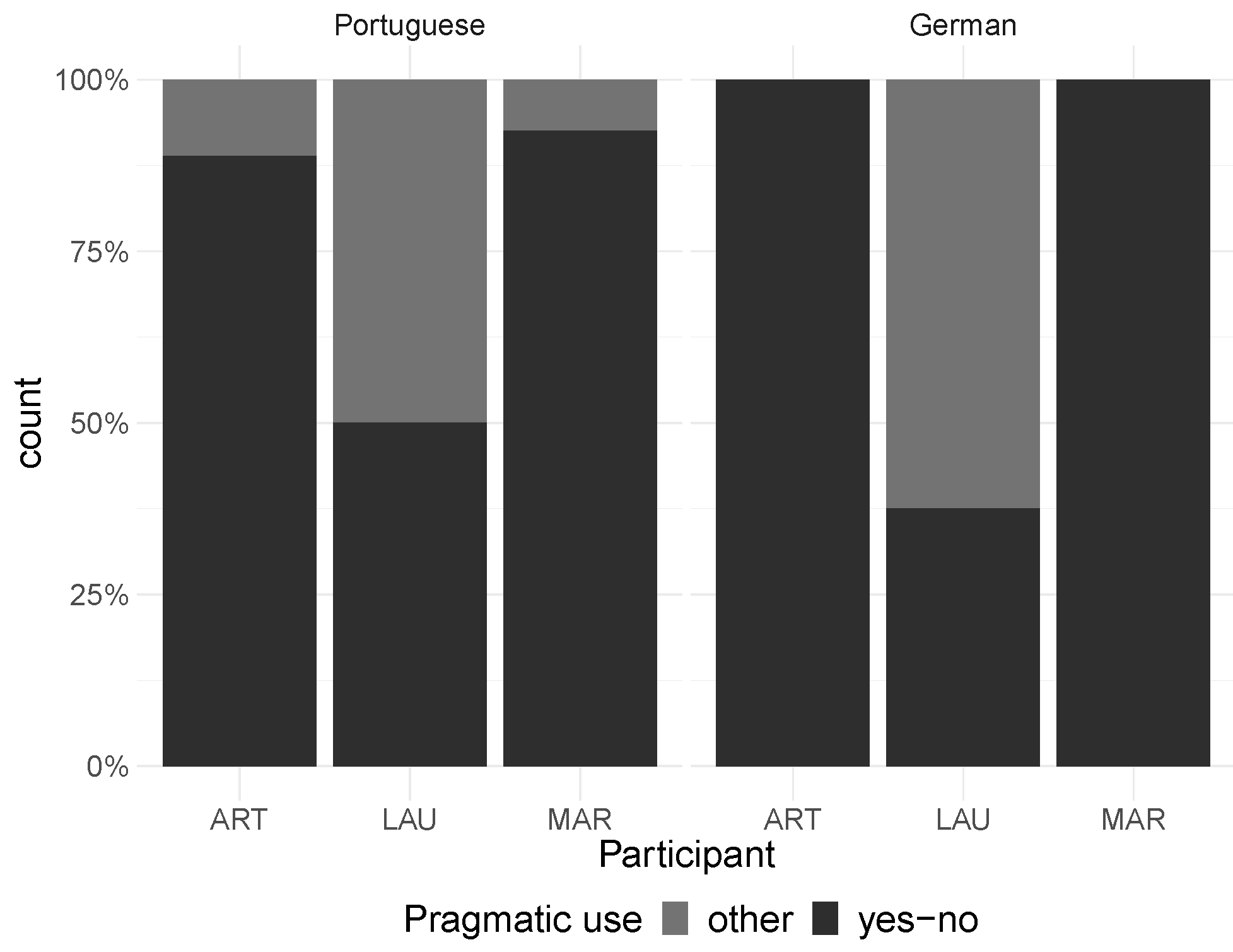
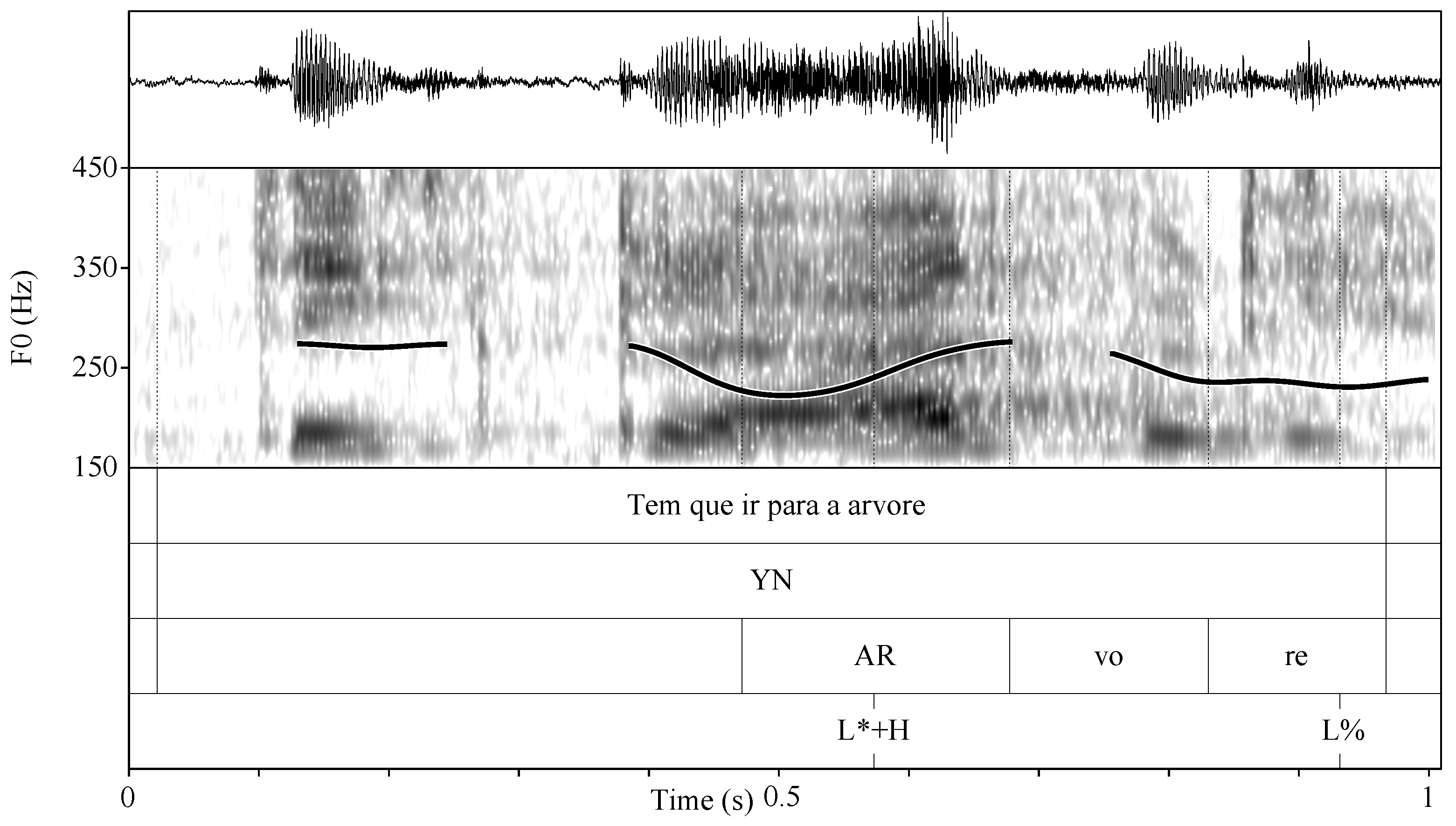
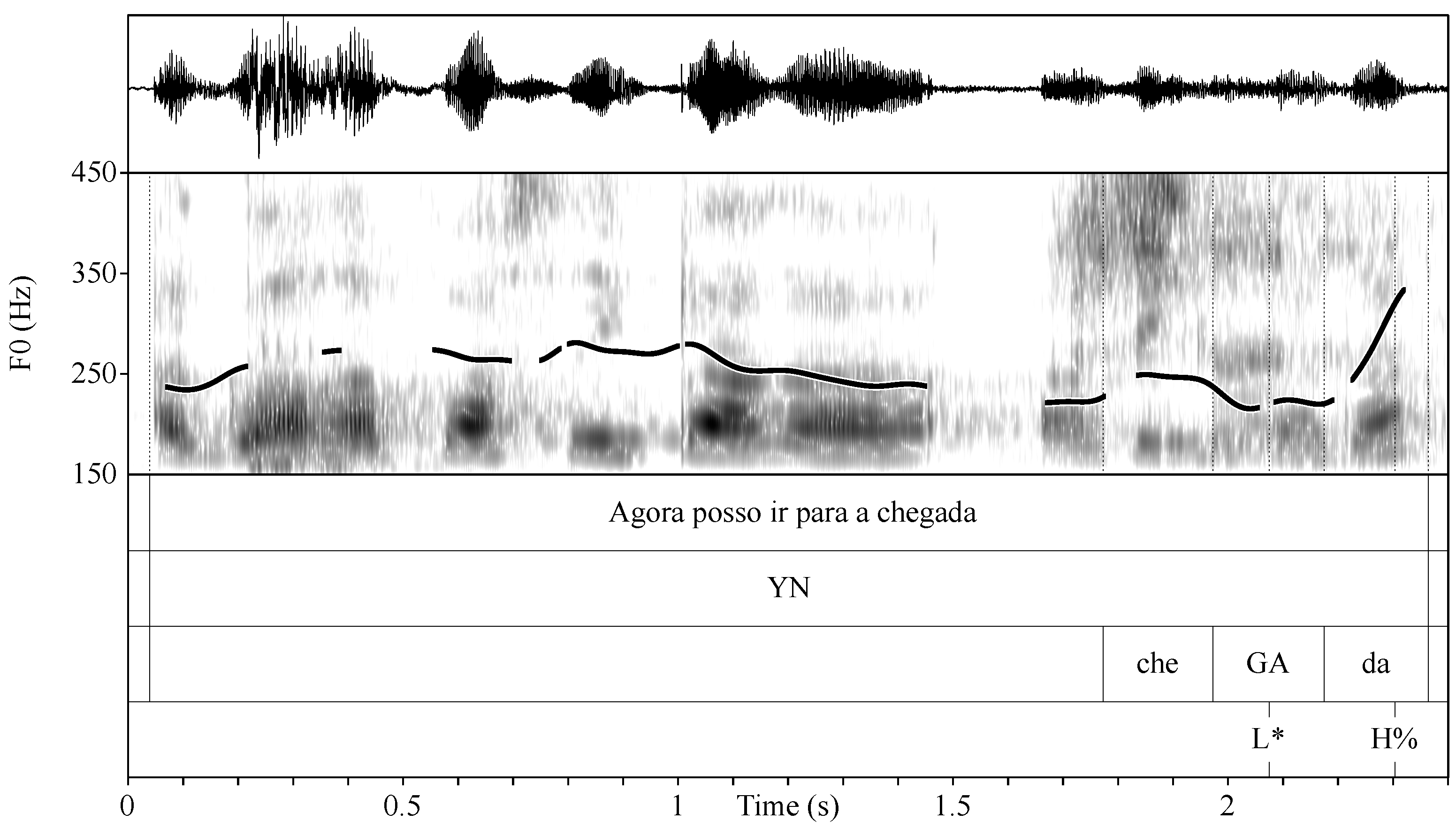

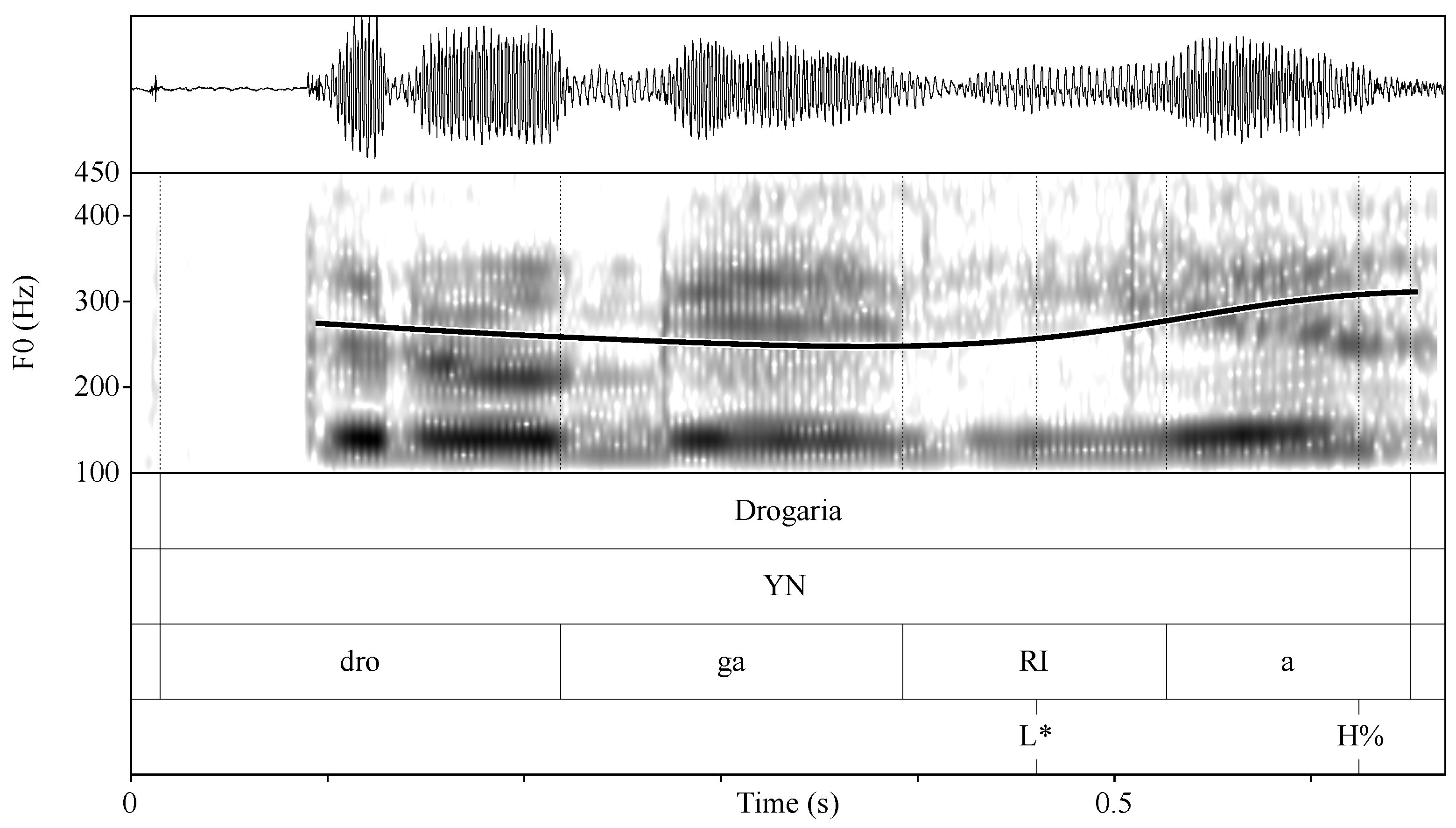
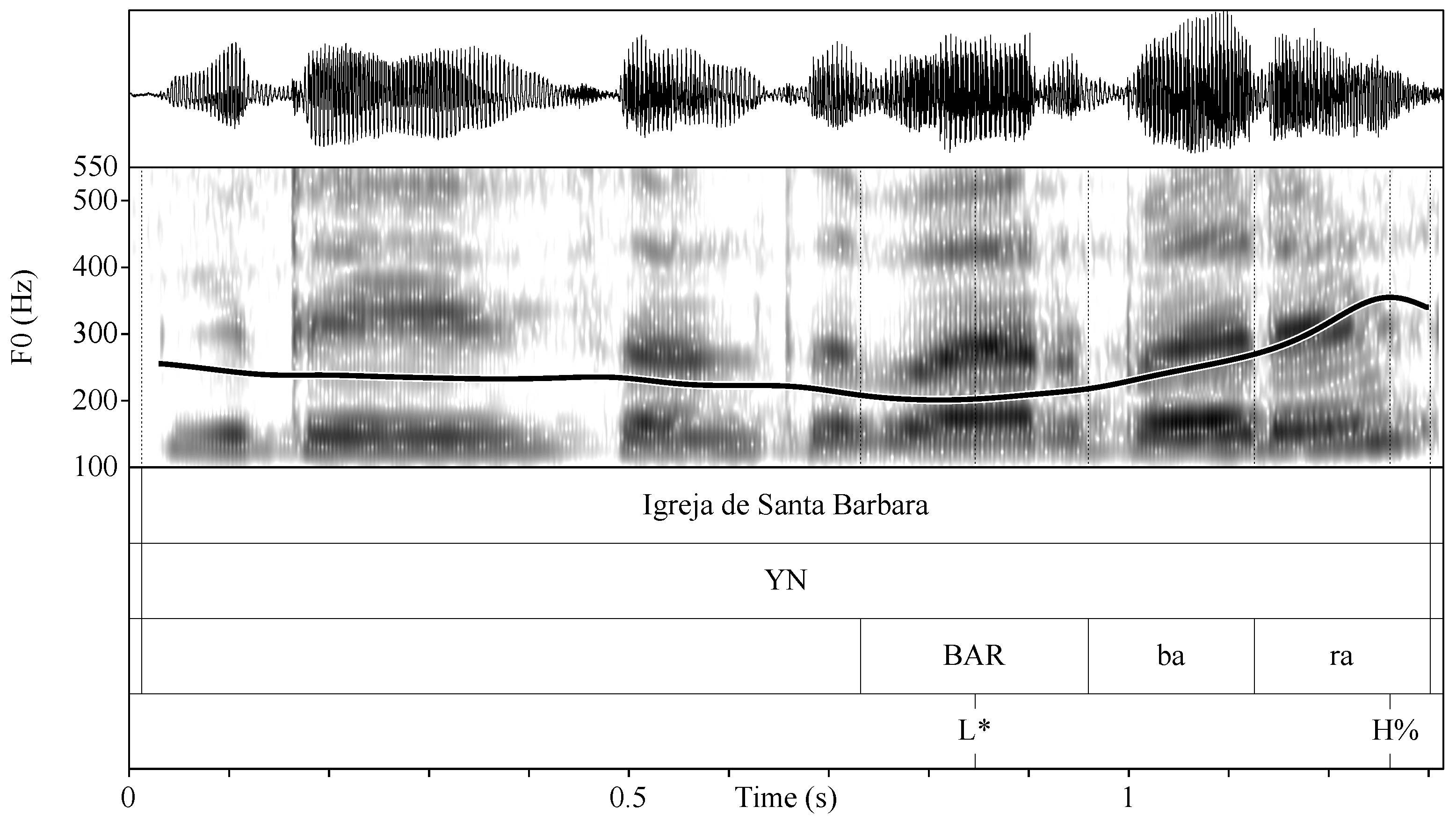

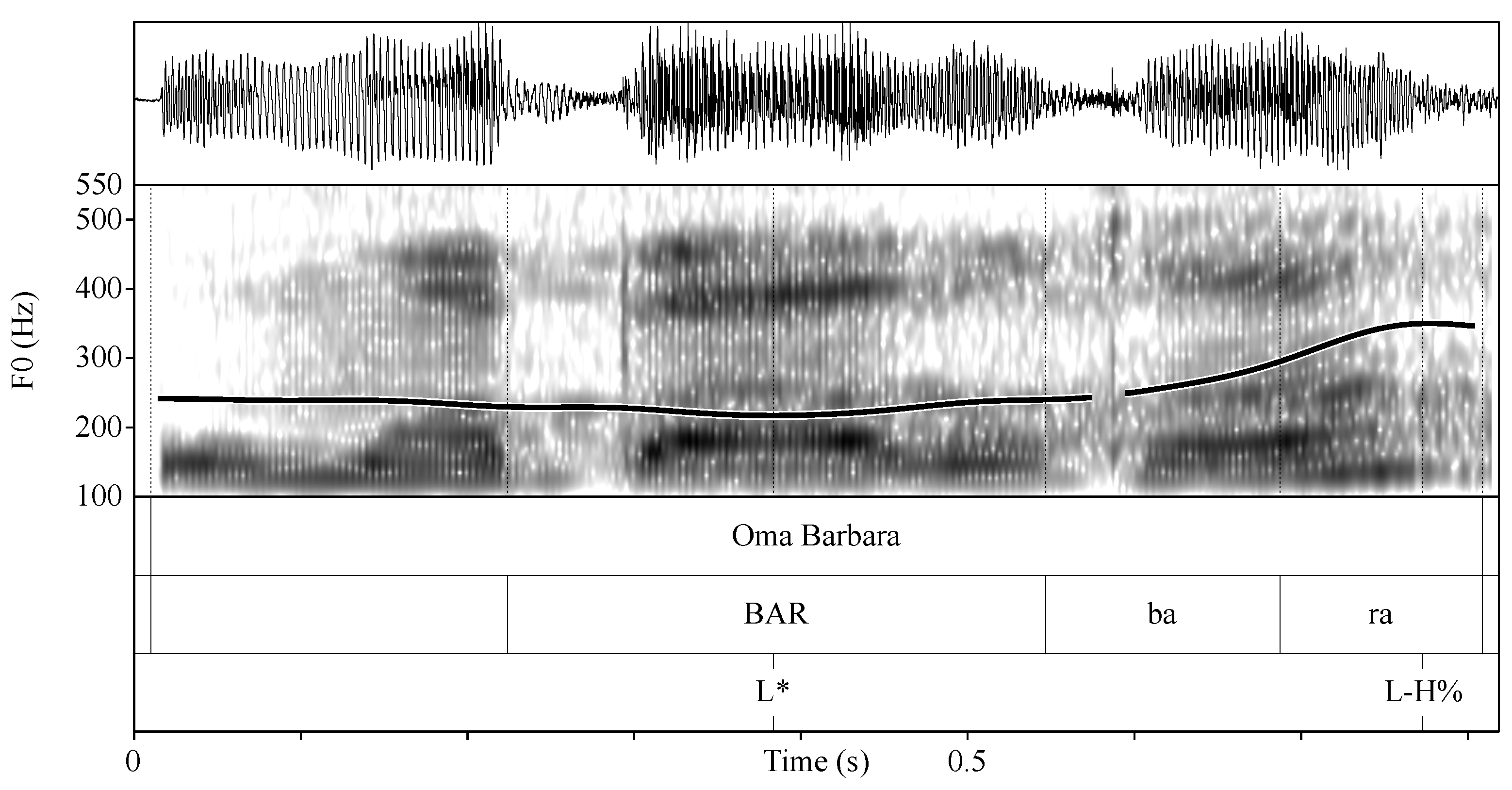

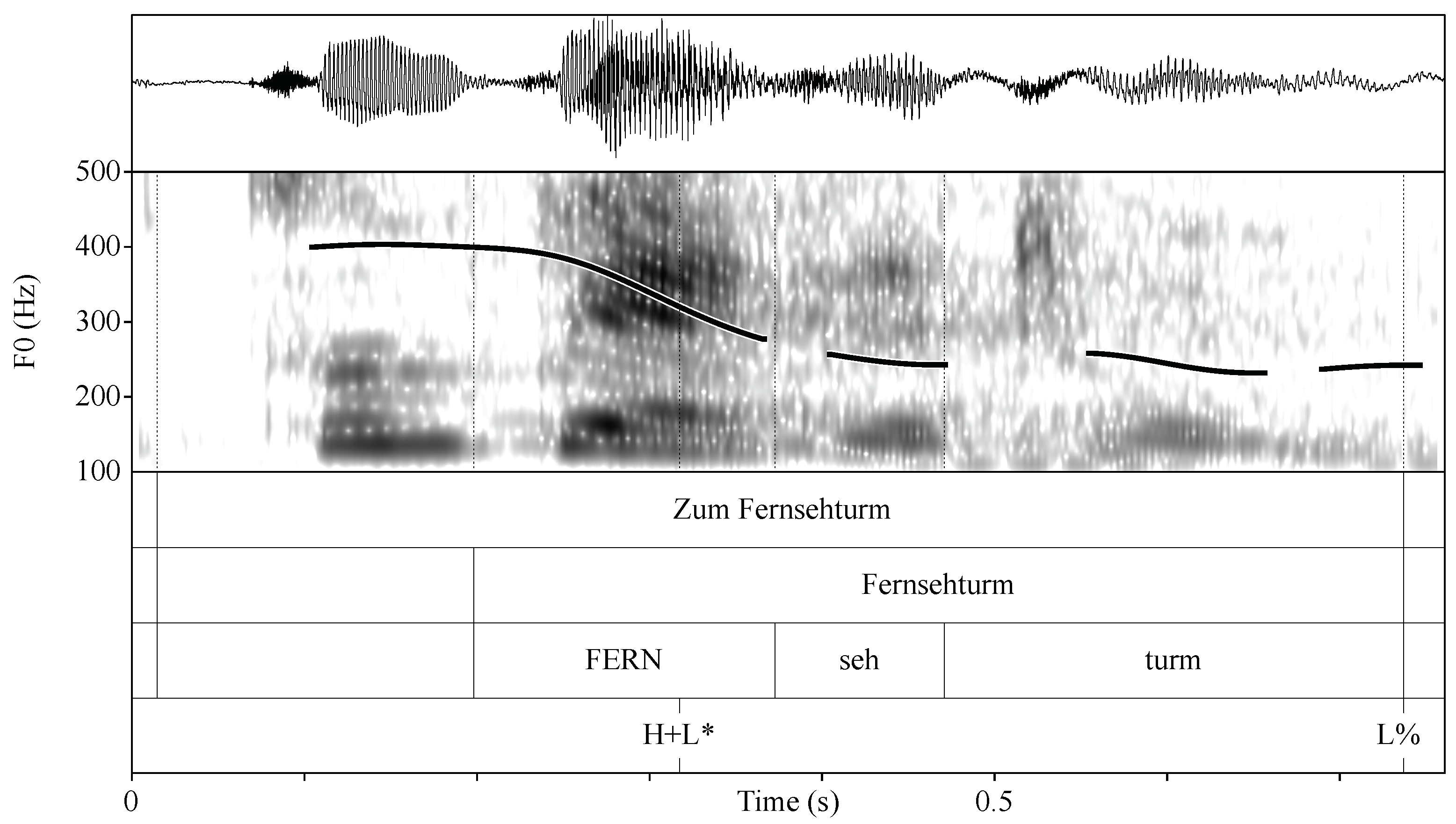
| Variety | Nuclear Accent | Boundary Tone | Source |
|---|---|---|---|
| Standard European Portuguese (SEP) | H+L* | LH% | Frota (2002) |
| Maputo Mozambique Portuguese (MMP) | L+<¡H* | L% | Serra and Oliveira (2022) |
| Florianópolis Brazilian | L+H* | L% | Silva (2012) |
| Portuguese (FLBP) | L+H* | H% | |
| L* | HL% | Castelo (2016) | |
| São Paulo Brazilian | L+H* | L% | Rosignoli and Fernandes-Svartman (2016) |
| Portuguese (SPBP) | L*+H | L% | |
| Rio de Janeiro Brazilian Portuguese (RJBP) | L+<H* | L% | de Moraes (2008) |
| Northeastern Brazilian | L* | H% | Castelo (2016) |
| Portuguese (NEBP) | L* | HL% |
| Language | Variety | Nuclear Accent | Boundary Tone | Syntax |
|---|---|---|---|---|
| Portuguese | SEP | H+L* | LH% | declarative |
| MMP | L+<¡H* | L% | declarative | |
| FLBP | L+H* | L% | declarative | |
| L+H* | H% | declarative | ||
| SPBP | L*+H | L% | declarative | |
| L+H* | L% | declarative | ||
| RJBP | L+<H* | L% | declarative | |
| NEBP | L* | H% | declarative | |
| L* | HL% | declarative | ||
| German | SG | L* | H-∧H% | inversion |
| L* | L-H% | inversion |
| Speaker/Variety | Word Stress | Tune Used | Expected | Count | Sum Percentage |
|---|---|---|---|---|---|
| ART | final | L* H% | yes | 2 | expected 54% |
| FLBP-speaker | final | L+H* H% | yes | 1 | |
| other | L*(+H) L% | yes | 9 | ||
| other | L+H* L% | yes | 1 | ||
| other | L* H% | no | 3 | not expected 46% | |
| other | L+H* H% | no | 8 | ||
| LAU | final | L* H% | yes | 7 | expected 56% |
| SPBP-speaker | final | L+H* H% | yes | 2 | |
| other | L* H% | no | 6 | not expected 44% | |
| other | L+H* H% | no | 1 | ||
| MAR | final | L* H% | yes | 21 | expected 99% |
| SEP-speaker | other | L* H% | yes | 48 | |
| other | L+H* H% | no | 1 | not expected 1% |
| Speaker | Partner | Tune used | Count | Percentage |
|---|---|---|---|---|
| ART | (1) RJBP-speaker | L*(+H) L% | 9 | 69% |
| FLBP-speaker | (L+<H* L%) | L+H* L% | 1 | 7% |
| L* H% | 3 | 24% | ||
| (2) German-dominant | L+H* H% | 9 | 82% | |
| (L* H-∧H%) | L* H% | 2 | 18% | |
| LAU | (1) SEP-speaker | L+H* H% | 2 | 22% |
| SPBP-speaker | (H+L* LH%) | L* H% | 11 | 78% |
| (2) German-dominant | L+H* H% | 1 | 7% | |
| (L* H-∧H%) | L* H% | 2 | 93% | |
| MMP (L+<¡H* L%) | ||||
| MAR | (1) SEP-speaker | L* H% | 51 | 100% |
| SEP-speaker | (H+L* LH%) | |||
| (2) German-dominant | L* H% | 18 | 95% | |
| (L* H-∧H%) | L+H* H% | 1 | 5% | |
| NEBP (L* H%, L* HL%) |
| Speaker | Partner | Tune Used | Count | Percentage |
|---|---|---|---|---|
| ART | (1) RJBP speaker | L* H-∧H% | 6 | 30% |
| FLBP speaker | (L*+H L%) | L* L-H% | 14 | 70% |
| LAU | low proficiency | L* H-∧H% | 4 | 50% |
| SPBP speaker | in Portuguese | L* L-H% | 4 | 50% |
| MAR | (1) SEP speaker | L* H-∧H% | 5 | 21% |
| SEP speaker | (H+L* LH%) | L* L-H% | 19 | 79% |
Disclaimer/Publisher’s Note: The statements, opinions and data contained in all publications are solely those of the individual author(s) and contributor(s) and not of MDPI and/or the editor(s). MDPI and/or the editor(s) disclaim responsibility for any injury to people or property resulting from any ideas, methods, instructions or products referred to in the content. |
© 2024 by the author. Licensee MDPI, Basel, Switzerland. This article is an open access article distributed under the terms and conditions of the Creative Commons Attribution (CC BY) license (https://creativecommons.org/licenses/by/4.0/).
Share and Cite
Torres, C. Portuguese and German Intonation Contours in a Two-Way Immersion School. Languages 2024, 9, 54. https://doi.org/10.3390/languages9020054
Torres C. Portuguese and German Intonation Contours in a Two-Way Immersion School. Languages. 2024; 9(2):54. https://doi.org/10.3390/languages9020054
Chicago/Turabian StyleTorres, Catalina. 2024. "Portuguese and German Intonation Contours in a Two-Way Immersion School" Languages 9, no. 2: 54. https://doi.org/10.3390/languages9020054
APA StyleTorres, C. (2024). Portuguese and German Intonation Contours in a Two-Way Immersion School. Languages, 9(2), 54. https://doi.org/10.3390/languages9020054





